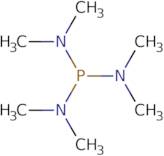Hexamethylphosphorous triamide
CAS: 1608-26-0
Ref. 3D-FH23805
| 10g | Discontinued | ||
| 25g | Discontinued | ||
| 50g | Discontinued | ||
| 100g | Discontinued | ||
| 250g | Discontinued |
Product Information
- Hexamethyl-phosphorous triamideN,N,N',N',N'',N''-Hexamethyl-phosphorous triamideHexamethyltriaminophosphine
- Hexametapil
- Hexamethylphosphorus triamide
- Hexamethyltriamidophosphite
- Hexamethyltriaminophosphine
- Hmpt
- N,N,N′,N′,N′′,N′′-Hexamethylphosphorous triamide
- Nsc 102707
- Phosphorous triamide, N,N,N',N',N'',N''-hexamethyl-
- Tris(Dimetilamino)Fosfina
- See more synonyms
- Tris(dimethylamino)phosphin
- Tris(dimethylamino)phosphine
- Trisdimethylaminophosphorus
- Phosphorous triamide, hexamethyl-
- 2,2,6,6-tetramethylpiperidine-1,4-diol
Hexamethylphosphorous triamide (HMT) is an activator that is used in pharmaceutical preparations. It is a white, water-soluble powder that reacts with carbonyl groups to form nitriles. Nitriles are useful intermediates in organic synthesis reactions because they are readily convertible to carboxylic acids, amides, and esters. HMT has been shown to be effective in the treatment of inflammatory diseases such as rheumatoid arthritis and psoriasis by inhibiting the production of prostaglandins and leukotrienes. HMT also binds to DNA polymerase and inhibits RNA synthesis. The reaction mechanism starts with the addition of a halide substrate or diphenyl ether to the activated complex of HMT. This causes a rearrangement of the phosphorous center and formation of an alkanoic acid product with an N-H group on one end and a carbonyl group at the other end. The transfer reactions occur





